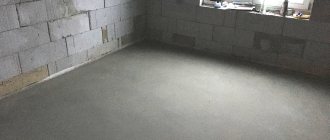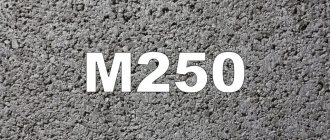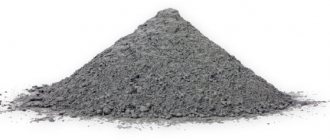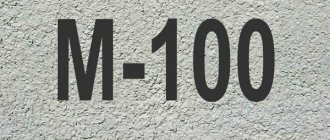Concrete is an irreplaceable material used in almost any construction work. Heavy concrete M300 is a combination of the best technical performance and affordable price. One of the few, concrete 300 is used in private construction, since its preparation does not require special knowledge and skills.
Concrete M300 is the best option for the construction and production of various concrete products (blocks, slabs, piles, etc.); experts value it for its versatility and reliability.
Advantages of grade 300 concrete:
- Strength and high strength indicators;
- Resistance to weather conditions (frost, temperature changes), so concrete 300 can be used in various climatic zones;
- Moisture resistance – allows the use of concrete products in damp places;
- Thermal conductivity;
- Durability of concrete products;
- Fire resistance – concrete does not burn or melt;
- Safety and environmental friendliness (contains no toxic substances);
- Low price;
- Possibility to improve performance when using additives.
In this article, we will take a detailed look at M300 concrete, answer the question of how to prepare M300 concrete with your own hands and what is required for this, and find out what the material is used for.
Characteristics of concrete M300
To describe the features and identify the advantages of concrete, it is worth considering the key characteristics of M300 concrete, this will help show why the M300 brand is the most popular on the market.
Concrete 300 has strength classes B22.5 and B25 and grade M300. It is characterized by great strength, density and increased elasticity. Experts use this concrete solution in places with high loads.
Specific gravity and density of concrete - M300 concrete is a heavy concrete with a weight of 1,800 to 2,500 kg. The weight directly depends on the type of crushed stone filler - heavy concrete M300 on granite weighs from 2000 to 2,500 kg, on limestone 1,800 - 1,900 kg.
A weight of less than 1,800 kg/m3 is an indicator of defective material.
Thermal conductivity – the thermal conductivity coefficient of concrete is 0.7 W/(m*C).
Frost resistance - the frost resistance indicator for concrete is 300 - F150, but you can change it and increase it to F200 in this way:
- When making concrete mortar, use additives that affect the formation of air bubbles in the mass;
- When laying the mortar, use vibration machines to compact the concrete;
- Replace limestone with granite filler;
- When mixing the solution, use special plasticizers that increase resistance to frost.
Water resistance - a grade indicating the resistance of concrete to water is designated “W”. For hydraulic concrete grade 300, the indicator is W5 - 6, which means that the concrete does not absorb or release water at a pressure of 0.5 - 0.6 MPa. These indicators can be increased by using plasticizers.
The workability or workability of concrete is indicated by the letter “P”; it depends on the amount of water in the mixture and the presence of additives.
Mobility is of great importance when pouring a solution; the more mobile the mass, the more fluid it is and will be able to fill the mold without the formation of voids. To pour concrete mixture using pumping equipment, it is better to choose P4 or P5.
Mandatory certification
There is no mandatory certification for cement mortar, since the product is not subject to the CU TR and is not included in PP No. 982. It is mandatory to obtain a certificate only for cement, which is included in concrete as the main binding component.
In addition to the voluntary and QMS certificate, there is also a sanitary certificate, which is received in a form approved by the Expert Opinion of Rospotrebnadzor to confirm compliance with the requirements of the Customs Union in the event of the first release of a concrete brand on the Russian construction market or the territory of the Customs Union. Cement-sand mortar is tested in certification laboratories/centers that are in the unified register of the Customs Union.
Due to the fact that the average setting time of the finished concrete solution (regardless of whether we are talking about B15 or B25 concrete) is 60-180 minutes. By adding special plasticizers to the mixture, this period can be increased by 3-4 hours. The existence of such technologies makes it possible to import/export concrete to the border areas of neighboring countries.
Strength classes
The most important characteristic of concrete, which influences the area of application of the material, is its strength and ability to resist loads. The indicators of these characteristics are indicated during production in the grade and class of concrete mortar.
Product labeling is established by GOST; the grade of concrete is designated by the letter “M” and a numerical indicator that indicates the maximum pressure during compression. The tensile strength for M300 concrete is 300 kg/cm2.
In addition, concrete is divided into classes, the class indicates the compressive strength, expressed in megapascals (MPa) and designated “B”.
The class expresses the strength characteristics of concrete, based on the coefficient of variation of the mixture, and this indicator is influenced by the uniformity of composition and ratio of components.
According to average indicators, the concrete grade M300 corresponds to class B22.5, but may have other indicators.
| The coefficient of variation | 5% | 13,5% | 18% |
| Concrete class | B25 | B22.5 | B15 |
Heavy concrete M300 B25 is the strongest and is used during the construction of large facilities.
Certificate for concrete mixtures
A quality certificate for concrete is a special document of an established form that confirms the high level of product quality and compliance with its declared characteristics and established standards. To receive certification, concrete must undergo multiple levels of rigorous testing. Production and materials are also necessarily checked.
During the inspection process, inspectors study the conditions of preparation, aging, storage, testing of the product, and all main quality indicators. If compliance is established on all points, then the concrete mixture is awarded a certificate.
On the territory of the Russian Federation, concrete (M100, M150, M200 and other grades) is not included in the list of materials that are subject to mandatory certification in accordance with PP No. 982 (01.12.2009), the GOST R system. Due to the lack of strict control, certification of the concrete mixture is voluntary and often needed not by the inspection body, but by the manufacturing company itself to confirm the quality of the product to the customer.
What types of concrete certificates are there:
- Voluntary – one that the company applies for on its own.
- Certificate in the form of QMS.
- Sanitary certificate.
Several product items can be certified at the same time, and then a single document is issued for all verified items. A certificate of any type issued for concrete is valid for exactly one year. When the deadline expires, the entire procedure is repeated again to obtain a new document.
Features of issuing a passport for concrete:
- In accordance with GOST 28013-98, this document is issued for each batch of solution that arrives from the plant and can allow the volume produced during the day. When using concrete for civil construction or in the case of providing services to a third party, both documents must be available (if the mixture is purchased for your own needs, a certificate is not required, but a passport is desirable).
- The certificate and passport are the basis for disputes, resolution of various situations, and the possibility of a refund for the supply of low-quality solution.
- If there is neither a certificate nor a passport, even if the low quality of concrete is checked and confirmed, all claims against the manufacturer are considered false.
What should be indicated in the passport for concrete (it is advisable to buy M300, M400, M500 and other expensive brands only if you have this document): details of the parties, time and date of shipment, mark of conformity (if there is a certificate), composition number and volumes, class of concrete , workability, strength at design/intermediate age, data on filler and plasticizer.
Procedure for obtaining a certificate:
- Submission by the manufacturer of the product of an application of a certain sample, a complete package of documents to confirm quality, to a special certification center (accredited).
- Studying documents by employees of the representative documents center, approving the decision to carry out quality certification, developing a work plan.
- Selection of concrete samples for research to check all properties and indicators.
- Performing tests in a special laboratory, entering data into the protocol.
- Analysis by the certification center of all data, decision regarding the issuance of paper or refusal to issue (necessarily motivated).
- If the outcome is positive, registration and issuance of a certificate for the solution
Concrete composition 300
Components of the standard M300 concrete recipe:
- Cement M400 or M500;
- Purified water;
- Crushed stone filler – limestone, granite, etc.;
- Fine sand.
To obtain a high-quality M300 concrete mixture, it is important to use components that meet the standards specified in GOST.
The sand must be thoroughly cleaned of clay and other impurities, sifted, the size of a grain of sand should not be more than 2 mm. River, quarry or expanded clay sand is allowed to be used.
Manufacturers often add gravel, granite and limestone as crushed stone, the fraction size is from 5 to 20 mm.
To improve the density of the product, crushed stone of different sizes is added to the mass.
The main binding element is Portland cement of two grades - M400 and M500, it must be dry and without lumps.
The brand of cement affects the proportions of ingredients.
Voluntary certificate GOST R
A certificate of conformity for a concrete mixture is an official document confirming the quality, properties and performance. A voluntary certificate has the same legal force as a certificate of conformity with a mandatory certification system and is issued in a form format (an approved blue sample with a degree of protection).
A QMS certificate is a certificate of conformity that was obtained to confirm compliance with the basic requirements of ISO 9001 standards. For an enterprise, it can become a serious confirmation of the quality of products of a particular production. The QMS is a guarantee that the production processes and quality control of the company itself meet all modern requirements.
A timely completed document for a product will allow you to attract new customers, confirm the high quality of products for old ones, and avoid various disputes and litigation. Most large suppliers of cement-sand mixtures prefer to pay for inspections and receive certificates.
You can obtain the paper at any center accredited by the Federal Agency for Technical Regulation and Metrology. The inspection is always initiated by the manufacturer.
Proportions of concrete M300
The composition, ratio and technical conditions for the production of M300 concrete are controlled by GOST 7473-94, which defines the basic recipe for mixing concrete mortar.
To mix M300 concrete, the standards allow the use of one of two types of cement - grade M400 or M500. Each of these brands has distinctive characteristics that affect the proportions of ingredients included in the composition.
To find out how much cement, crushed stone and sand is needed per 1 m3 of M300 concrete, it is worth considering the recipe and proportions of the ingredients in each case.
When using Portland cement M400:
- Cement - 1 part;
- Sand – 1.9 parts;
- Crushed stone filler - 2.8 parts;
- Water – 0.6 parts.
When adding M500 cement:
- Portland cement – 1 part;
- Sand – 2.4 parts;
- Crushed stone filler – 4.3 parts;
- Water - 0.6 parts.
The higher the grade of Portland cement, the higher the consumption of other components.
To obtain a high-quality concrete solution, it is important to follow the sequence of adding components and accurately observe the proportions.
Current standards
According to current standards, a certificate for concrete (M250 or M500 - does not matter) can be of three types: sanitary, compliance with QMS and voluntary according to GOST R. The latter type of document is issued only after laboratory tests/inspections, during which full compliance with the specified requirements is established indicators, specifications and GOSTs.
Standards that apply to concrete solutions:
- Technical conditions - in accordance with GOST 7473 (2010), which defines the requirements for ready-made concrete solutions of various types (light, heavy, fine-grained concrete, etc.), their use in monolithic and prefabricated monolithic structures.
- Test methods - GOST 10181 (2014) is used, which specifies the rules for sampling and laying concrete mixtures, standards for stratification, density, temperatures, porosity and other conditions under which the material retains its properties and does not lose quality.
- The method for determining the setting time is in accordance with GOST R 56587-2015, which regulates the standards for the setting time of different mixtures.
Preparation of concrete m300
You can either mix M300 concrete yourself or buy a ready-made mixture in the store, to which you only need to add water according to the instructions.
So how to make grade 300 concrete with your own hands? First of all, you need to prepare the tools you will need for the job:
- Concrete mixer;
- Shovel for filling components;
- Bucket;
- Scales or measuring container to maintain proportions.
The work process is not complicated and does not require special knowledge:
- Do you need to measure first? or ? from the required amount of water and pour into a concrete mixer;
- The apparatus is turned on and the gradual introduction of cement begins - it is mixed with water until smooth, until a kind of “cement milk” is obtained;
- Crushed stone is poured in small portions, and then sand;
- The mass is mixed until a homogeneous solution is obtained, this will take at least 5 - 10 minutes.
Concrete is prepared immediately before starting work, since the setting time of the mixture begins from the moment the binder is combined with water.
Violation of the exact proportions of ingredients will lead to the production of a low-quality product.
So how long does it take for M300 concrete to harden? The time required for concrete to harden can be tracked using the strength gain graph of concrete M300, according to which the main indicators can be identified.
- The first 5 days are key; it is at this time that the process of intensive hardening of the solution occurs.
- After the first week, the concrete gains 70% strength;
- After 28 days – 95%.
Therefore, professionals advise continuing work no earlier than in a month.
The full strength of M300 concrete is achieved after 6 months
If the developer decides to purchase a ready-made mixture, you should carefully consider its choice and study:
- certificates of conformity and product quality;
- expiration dates;
- composition and brand (stores offer a large selection of mixtures for different purposes).
Dry concrete mix M300 is produced in bags of 25 and 50 kg. One of the most used concrete m300 is Istra, located in the city of Istra and produces the product of all varieties.
Kneading rules
How to mix sand concrete M300? Since this is a dry mixture, there is one strict rule - you need to pour sand concrete into a container with water, and not vice versa. Backfilling is carried out gradually with thorough mixing of the solution.
As soon as a homogeneous mass has formed, let it brew for 5 minutes, then stir thoroughly again. Keep in mind that the concrete hardening time is no more than 3 hours, so it must be used quickly. The main question of breeding is how much water is required? For one kilogram of mixture 0.15-0.18 liters.
Areas of use of M300 concrete
The scope of application of M300 concrete is quite wide; it is mainly used for private and industrial buildings, such as:
- low-rise general purpose buildings;
- Dachas and cottages;
- Outbuildings, garages, warehouses;
- High-rise buildings;
- Road construction;
- Industrial premises.
Such characteristics as strength, hardening time of concrete 300 and its preservation of a given shape allow it to be used for the manufacture of the following objects:
- Pavement tiles and curbs;
- Wall blocks;
- Stairs;
- Reinforced concrete structures;
- Piles and pillars;
- Ceilings and partitions.
M300 concrete mortar is used to form the foundation, install monolithic walls, blind areas and driveways. Builders also use concrete grade M300 for heated floors, when laying walls, plastering, as a self-leveling floor or screed.
Concrete grade 300 F2 is used by specialists for transport construction - laying roads, base for asphalt pavement, access roads, etc.
Registration process
Obtaining a certificate is quite easy - in this case, the main difficulty is the high cost of all work. Otherwise, it is enough to find a center certified by the relevant authorities and submit an application.
How to get a concrete certificate:
- Submit a package of documents to the center conducting the certification (it is better to first find out what is needed and collect all the papers in advance).
- Select the standards for compliance with which you plan to test the concrete mixture.
- Fill out an application of a certain sample.
- The center staff will provide samples for testing, which must pass all tests and studies.
- Receive a certificate of conformity.
- Submit documents for the next inspection in a timely manner.











